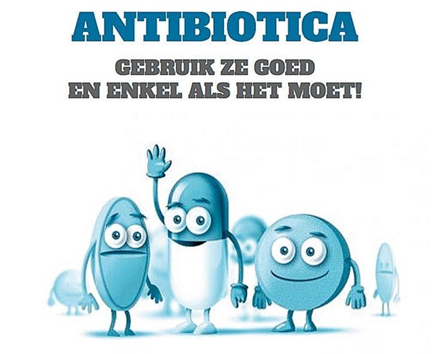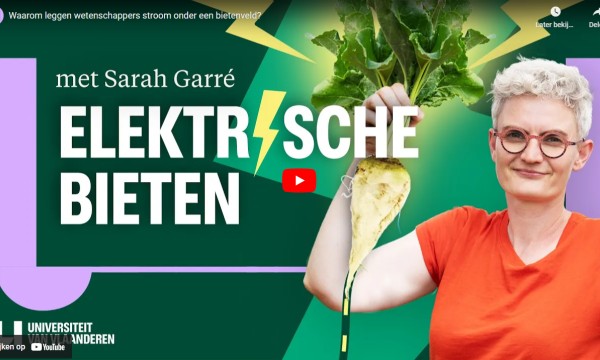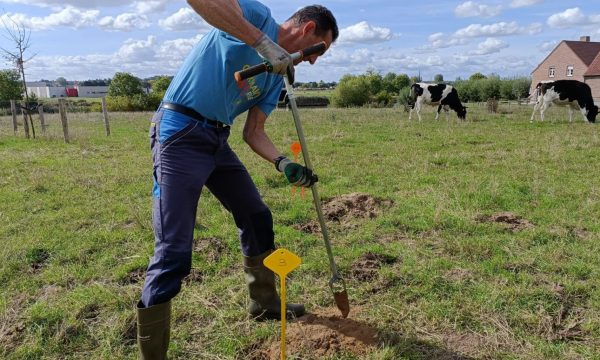Press release ILVO takes first steps to map spread of antibiotics and antibiotic resistance through manure

Follow-up research looks at impact on crops and humans
ILVO has developed a method that makes it possible to map the distribution of antibiotics via manure into the environment. With this method, 69 antibiotics can be detected at the same time, including difficult to detect colistin, an important medicine for humans. A first exploratory screening of a limited number of antibiotics in a limited number of manure and soil samples indicates the importance of further research.
Marc Heyndrickx (ILVO): "In the context of the ‘One Health’ fight against antibiotic resistance, it is important that we get more insight into the ways in which antibiotics and resistance genes spread to and from humans, animals and the environment. Tina Van den Meersche’s PhD research has taken the first steps toward mapping the environmental route."
Together with Ghent University and Université Catholique de Louvain, ILVO has already launched a follow-up study of the effect of antibiotic residues and resistance genes in soil on crops and a possible health risk for humans through the consumption of these crops. The importance of this is great because antibiotics are essential in the treatment of most of the bacterial infectious diseases in humans and animals.
Antibiotic resistance: A natural process accelerated by frequent use
Before World War II, millions of people worldwide died of infections caused by bacteria. This changed drastically through the application of antibiotics in human medicine. For about 80 years, this was considered a success story, but the problem of antibiotic resistant bacteria has grown ever since.
Resistance is a natural fact. Bacteria adapt to their environment by developing defense mechanisms against antimicrobial agents such as antibiotics. Each time an antibiotic is administered, the susceptible bacteria are killed or slowed down, and more resistant bacteria may get more room to grow. This results in selection for these resistant bacteria. In addition, some bacteria can pass resistance genes to other bacteria, which further increases the problem. Because of the frequent use of antibiotics in human and animal medicine, this process of resistance has seen rapid acceleration.
One Health: From animal to human and vice versa, also through the environment?
The seriousness of the problem of antibiotic resistance is recognized worldwide. In the fight against it, the World Health Organisation (WHO) puts the One Health principle first: Since people and animals live in the same ecosystem where cross-contamination is possible, the fight against antibiotic resistance must be fought on both fronts. The occurrence of antibiotic-resistant bacteria in humans is mainly due to the human use itself, but a small part is the result of use in veterinary medicine. The best known spread route of antibiotics (resistance) from animal to human is directly through the consumption of animal products. Marc Hendrickx (ILVO): "It is important to also investigate the possibility of an indirect route through the environment. Through manure, antibiotics and antibiotic resistant germs can end up in the soil, on and in plants, and in soil and surface water. We still know very little about the importance of this transfer. Tina Van den Meersch’s PhD research has taken the first steps to chart this for Flanders."
First exploratory research in Flanders on a limited number of samples
Every year, around 40,000 tonnes of pig manure are produced in Flanders, about half of which are spread as raw manure over grassland and fields on which feed and to a lesser extent also vegetables are grown. This makes pig farming an interesting case for a first exploratory study. Van den Meersch therefore took samples in manure cellars on seven Flemish pig farms and soil samples at different times (from before fertilization until after harvest) of five different agricultural fields (clay and sand loam). In these samples, she searched for residues of a limited number of antibiotics and resistance genes.
For this purpose she developed a validated liquid chromatic/mass spectrometric multi-residue method. Using this method, multiple antibiotics in multiple antibiotic classes can be quantified, which represents a major advance in relation to the existing methods that allow only one or a few antibiotics to be screened simultaneously. In addition, this method can quantify colistin, an antibiotic considered as a priority by the WHO for human medicine. This antibiotic cannot be traced with other methods.
Certain types of antibiotics can remain stable in pig manure in the manure cellars and even in certain soil types.
Tina Van den Meersch discovered that pig manure can sometimes contain antibiotic residues with varying concentrations depending on the type. For example, If a pig was treated with trimethoprim, it can only be found in lower concentrations in the fertilizer samples, while doxycycline may be present after treatment in higher concentrations in manure. Tina Van den Meersch: "It is known that some antibiotics are well absorbed by the animals and others are not. In The latter case, a larger part of the antibiotic is excreted unchanged in the manure. In addition, there is a significant difference in the stability of antibiotics. Some break down quickly in manure, while others can stay stable for a long time."
The latter also emerged from the exploratory study: Some antibiotics can stay present for a long time in manure cellars, while others disappear quickly. An even more complex picture arises as soon as the manure-with-antibiotic residues is spread on the field. Not only the type of antibiotic, the time (how long stable after spreading?), the further dilution (factor 10-100) but also the type of soil all seem to influence whether antibiotic residues are found in soil samples.
First indications for short survival of pathogenic bacteria and antibiotic resistance genes in the soil
The intestines of pigs can house pathogenic bacteria such as Salmonella and Campylobacter. Both are known to be transferable to humans. The route from pork to human was already mapped out earlier. Tina Van den Meersch also found that if they are present in manure, they can also be present in fertilized soils. After a month, however, these pathogens are no longer detectable in the soil.
Finally, the exploratory study found that pigs are carriers of antibiotic resistance genes. These are genes that can cause bacteria to become impervious to antibiotics. Tina Van den Meersch studied their presence in the pig, as well as in pig manure and fertilized soil. It is remarkable that they already found antibiotic resistance genes in soil samples – even before the soil was fertilized. Immediately after fertilization (with manure-with-antibiotic resistance genes) the numbers increase, depending on the concentrations in the manure, and over time they fall again to the levels before fertilization. The soil samples without antibiotic residues also contain as many resistance genes as the samples with antibiotic residues. The presence or absence of antibiotics in the soil therefore does not have a clear effect on the number of resistance genes in that soil.
Manure processing may result in reduction
In Flanders, part of the manure is processed to reduce the risk of leaching of nutrients to the surface and groundwater by over-fertilization. In 2016, this was 34% of total manure production, which was processed in 124 installations. The technique Most often used to process pig manure is biological processing or simply biology. Tina van den Meersch studied whether this processing affected the presence of antibiotics, resistance genes and pathogenic bacteria. She took samples on two companies in six different phases of the processing process. But the effect she found was rather limited. Van den Meersch: "Biology is aimed at reducing nitrogen and phosphorus in manure, not antibiotics or bacteria. However, we saw a limited decrease in both antibiotic residues and resistance genes after processing. The greatest effect was seen in Salmonella, Campylobacter and E. coli, is an indicator organism that can indicate the presence of other harmful organisms from manure. For Salmonella and Campylobacter we saw a decrease by factor 10 and for E. coli a decrease by factor 10-10,000."
Need for follow-up research: 3 projects are already running
The greatest merit of Tina Van den Meersch’s research is that, on the one hand, it has produced a method for quicker detection of more different antibiotics – the method has meanwhile been further optimized and extended to 69 antibiotic residues – and it also points to the importance of follow-up research.
Marc Heyndrickx (ILVO): "This is an exploratory study based on a limited number of samples, which makes it impossible to draw generalized conclusions. But it does provide us with important insights for further research. There was for instance no difference in the number of resistance genes in the manure of pigs that recently had no antibiotics and pigs that were recently treated. We cannot explain this at this time. An interesting follow-up study would therefore be to compare the number of resistance genes in manure between pigs coming from farms that administer few antibiotics (e.g. in organic production) and pigs from farms that administer antibiotics more frequently."
Together with UGent and UCLouvain, ILVO has already started a follow-up research (AMRESMAN) to reveal the impact of antibiotic residues and resistance genes in the soil on the crops that grow, and whether there is a risk to humans if they consume vegetables (leeks) grown on such soils. The results of this study are expected in 2021. Els Daeseleire (ILVO): "On the basis of literature research we expect in vegetables no or much smaller concentrations than what is permitted in meat. After all, the concentrations that we found in the soil samples of Tina Van den Meersch, will be diluted even further. Of course, this presumption should be tested through tests in practice." Geertrui Ruysschaert (ILVO): "We are also going to investigate whether the antibiotic resistance is passed from bacteria from the manure or soil to bacteria to the vegetables being grown."
On behalf of the Flemish Environmental Company (VMM), ILVO carried out two more studies on the indirect distribution route. One study focuses on antibiotic residues in manure at the time of spread and the other focuses on the presence of antibiotics in surface and groundwater. The results of the manure research are available online on the website of the VMM; the results of the water research are expected in mid-2019.
Tina Van den Meersch (ILVO): "The most important message is and remains: use antibiotics well and only if you absolutely have to."


